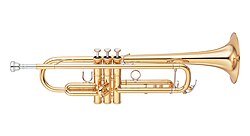
Back Trompet Afrikaans Trompete ALS ትራምፔት Amharic Trompeta AN Bīeme ANG بوق Arabic ترومبيت ARZ Trompeta AST Truba (musiqi aləti) Azerbaijani Торба (музыка ҡоралы) Bashkir
This article needs additional citations for verification. (October 2019) |
 Trumpet in B♭ | |
| Brass instrument | |
|---|---|
| Classification | |
| Hornbostel–Sachs classification | 423.233 (Valved aerophone sounded by lip vibration) |
| Playing range | |
 | |
| Related instruments | |
| flugelhorn, cornet, cornett, flumpet, bugle, natural trumpet, bass trumpet, post horn, Roman tuba, buccina, cornu, lituus, shofar, dord, dung chen, sringa, shankha, lur, didgeridoo, alphorn, Russian horns, serpent, ophicleide, piccolo trumpet, horn, alto horn, baritone horn, pocket trumpet | |
| Part of a series on |
| Musical instruments |
|---|
The trumpet is a brass instrument commonly used in classical and jazz ensembles. The trumpet group ranges from the piccolo trumpet—with the highest register in the brass family—to the bass trumpet, pitched one octave below the standard B♭ or C trumpet.
Trumpet-like instruments have historically been used as signaling devices in battle or hunting, with examples dating back to at least 2000 BC.[1] They began to be used as musical instruments only in the late 14th or early 15th century.[2] Trumpets are used in art music styles, for instance in orchestras, concert bands, and jazz ensembles, as well as in popular music. Sound is produced by vibrating the lips in a mouthpiece,[3] which starts a standing wave in the air column of the instrument. Since the late 15th century, trumpets have primarily been constructed of brass tubing, usually bent twice into a rounded rectangular shape.
There are many distinct types of trumpet, with the most common being pitched in B♭ (a transposing instrument), having a tubing length of about 1.48 m (4 ft 10 in). Early trumpets did not provide means to change the length of tubing, whereas modern instruments generally have three (or sometimes four) valves in order to change their pitch. Most trumpets have valves of the piston type, while some have the rotary type. The use of rotary-valved trumpets is more common in orchestral settings (especially in German and German-style orchestras), although this practice varies by country. A musician who plays the trumpet is called a trumpet player or trumpeter.[4]
- ^ White, H.N. (25 June 2023). "History of the Trumpet and Cornet". Trumpet-history.com. Retrieved 25 June 2023.
- ^ "History of the Trumpet (According to the New Harvard Dictionary of Music)". petrouska.com. Archived from the original on 8 June 2008. Retrieved 17 December 2014.
- ^ "Brass Family of Instruments: What instruments are in the Brass Family?". www.orsymphony.org. Retrieved 12 May 2020.
- ^ Koehler 2013
© MMXXIII Rich X Search. We shall prevail. All rights reserved. Rich X Search